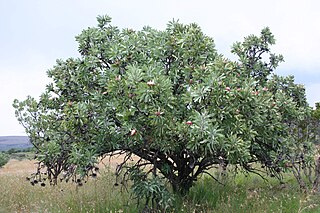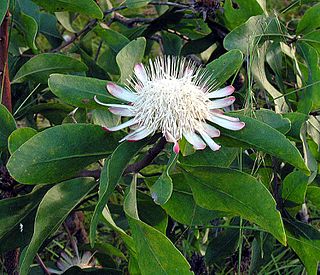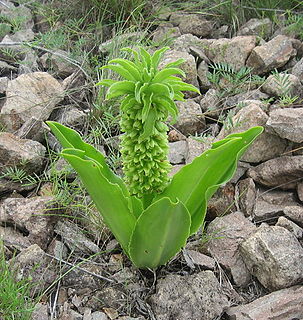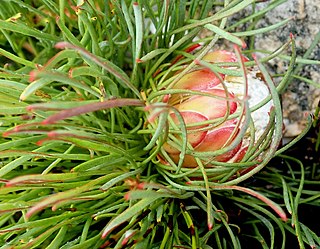
Clivia miniata, the Natal lily or bush lily or kaffir lily, is a species of flowering plant in the genus Clivia of the family Amaryllidaceae, native to woodland habitats in South Africa as well as in Eswatini. Given suitable conditions it grows into large clumps and is surprisingly water wise. It is also reportedly naturalized in Mexico. It is a popular plant for shady areas and is commonly seen growing in older established suburbs in most Australian states. It is also popular in New Zealand, Japan, China and the US, particularly California.

Thunbergia is a genus of flowering plants in the family Acanthaceae, native to tropical regions of Africa, Madagascar and southern Asia. Thunbergia species are vigorous annual or perennial vines and shrubs growing to 2–8 m tall. The generic name honours the Swedish naturalist Carl Peter Thunberg (1743-1828).

Vatricania is a monotypic genus of flowering plants belonging to the family Cactaceae. It just contains one species, Vatricania guentheri(Kupper) Backeb.Greenm. ex Gleason It has the common name of Red Tail Cactus.

Quercus castaneifolia, the chestnut-leaved oak, is a species of oak in the turkey oak section Quercus sect. Cerris. It is native to the Caucasus and Alborz mountains of Iran, and resembles the closely related Turkey Oak in appearance.

Thunbergia alata, commonly called black-eyed Susan vine, is a herbaceous perennial climbing plant species in the family Acanthaceae. It is native to Eastern Africa, and has been naturalized in other parts of the world.

Protea caffra, native to South Africa, is a small tree or shrub which occurs in open or wooded grassland, usually on rocky ridges. Its leaves are leathery and hairless. The flower head is solitary or in clusters of 3 or 4 with the involucral bracts a pale red, pink or cream colour. The fruit is a densely hairy nut. The species is highly variable and has several subspecies.

Protea gaguedi is a species of tree which belongs to the genus Protea.

Gardenia thunbergia is a sturdy large shrub or small tree endemic to the southern and eastern regions of South Africa and neighbouring territories such as Eswatini. It grows largely in forest or on forest margins, occurring in the Eastern Cape, Natal and Transkei in South Africa. It is densely twiggy and rigid with smooth light-grey bark, and is horticulturally valuable, being easy to grow as a strong hedge, but more usually as a specimen plant, striking in appearance and long lived. The abundant and extremely fragrant flowers are about 70 mm in diameter with long tubes only accessible to the proboscises of nocturnal hawkmoths. The leaves are smooth, shiny, whorled and entire, and clustered at the ends of branchlets. The fruit is oval, hard, woody and fibrous, about 80 mm long and about 40 mm in diameter, light grey with small raised white spots and if not eaten by large browsers or elephant, will remain on the tree for years. Its common names include forest gardenia, mutarara, tree gardenia, white gardenia and wild gardenia. In Afrikaans it is variously known as buffelsbol, stompdoring, or wildekatjiepiering.

Eucomis autumnalis, the autumn pineapple flower, or autumn pineapple lily, is a species of flowering plant in the family Asparagaceae, subfamily Scilloideae, native to Malawi, Zimbabwe and southern Africa. It is a mid to late summer flowering deciduous bulbous perennial. The flower stem reaches about 40 cm (16 in), rising from a basal rosette of wavy-edged leaves. The green, yellow or white flowers are arranged in a spike (raceme), topped by a "head" of green leaflike bracts. It is grown as an ornamental garden plant and can also be used as a cut flower.

Barberetta is a genus of herbaceous perennial plants in the family Haemodoraceae. It contains only one known species, Barberetta aurea.

Protea effusa, sometimes known as the scarlet sugarbush, is a flowering plant which belongs to the genus Protea. The plant is endemic to the Western Cape province of South Africa. In the Afrikaans language the vernacular name blosrooisuikerbos has been recorded for this plant.

Protea pendula, also known as the nodding sugarbush or arid sugarbush, is a flowering plant of the genus Protea, in the family Proteaceae, which is only found growing in the wild in the Cape Region of South Africa. In the Afrikaans language it is known as knikkopsuikerbossie or ondersteboknopprotea.

Protea recondita, also known as the hidden sugarbush, is a flowering plant of the genus Protea within the family Proteaceae, which is endemic to the Cape Region of South Africa, and distributed from the Piketberg and Cederberg to the Groot Winterhoek mountains. The flowers of this unusual plant are pollinated by non-flying mammals: rodents and elephant shrews. In the Afrikaans language it is known as gesigtoehouprotea or skaamroos.

Protea montana also known as the Swartberg sugarbush, is a flowering plant of the genus Protea within the family Proteaceae, which is endemic to the southwestern Cape Region of South Africa. In Afrikaans it is known as swartbergsuikerbos.

Protea burchellii, also known as Burchell's sugarbush, is a flowering shrub in the genus Protea, which is endemic to the southwestern Cape Region of South Africa.

Protea decurrens, also known as linear-leaf sugarbush, is a shrub of the genus Protea, in the Proteaceae family, which is endemic to the southwestern Cape Region of South Africa. It is a small shrub with a thick underground rootstock, this structure throwing up numerous leafy branches, upon the base of which clusters of flower heads may appear close to the ground. It is pollinated by rodents and grows in low-altitude fynbos or renosterveld.

Amaranthus muricatus, the so-called African amaranth, is a species in the genus Amaranthus native to South America; Bolivia, Paraguay, Argentina and Uruguay. It is an invasive species in Africa, Europe and Australia, and to a lesser degree in North America and Asia. It is a decumbent perennial that does well in arid climates.

Oenothera versicolor, the red evening-primrose, is a species of flowering plant in the family Onagraceae, native to South America, from Peru and Ecuador down to Bolivia and Northern Argentina This species is not as common in cultivation as other members of the genus but popular cultivars including 'Sunset Boulevard' are grown in gardens around the temperate world as the plant is hardy down to at least -10'c.

Hewittia malabarica is a flowering plant in the monotypic genus HewittiaWight & Arn., belonging to the family Convolvulaceae and widespread throughout tropical Africa, Asia, and Polynesia. It is a climbing or prostrate perennial herb with slender stems and flowers that are pale yellow, cream, or white with a purple center, and large leaves that can be used as a cooked vegetable or used in folk medicine with the roots. The stems can be used to make ropes.

Indigofera hilaris, the Red bush indigo or Gay indigofera, is a species of leguminous shrublet in the genus Indigofera.























